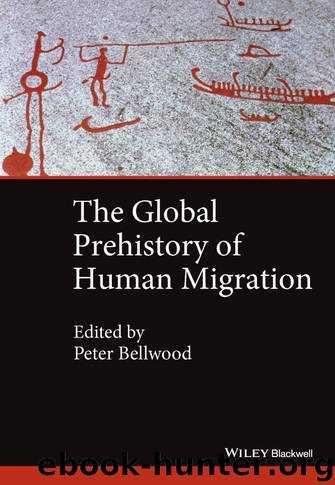The Global Prehistory of Human Migration by Bellwood Peter; Ness Immanuel; Bellwood Peter

Author:Bellwood, Peter; Ness, Immanuel; Bellwood, Peter
Language: eng
Format: epub
ISBN: 9781444334890
Publisher: John Wiley & Sons, Incorporated
Published: 2014-08-22T12:29:22+00:00
Early Holocene hunter-gatherer migrations and the emergence of early farmers
During the Last Glacial Maximum, at about 20 kya, and in the following period of glacial retreat, microblade assemblages spread southwards to the Huai River and northern Jiangsu province, between the Yellow and Yangzi rivers. The site of Dagang in Henan province (lower Yellow River valley) is the southernmost find place of microblades, here dated to about 9000 bce (Zhang & Li 1996). After this time, the microblade assemblages of northern China began to retreat into Inner Mongolia and northeast China, to be replaced gradually to the south by Neolithic assemblages with increasing quantities of pottery and grindstones, often in association with continuing but diminishing numbers of microblades. A representative site of this cultural phase is located at Donghulin in Beijing City (SAMPU 2006). At the same time, populations in the Yangzi basin to the south began to establish the first village settlements. Shangshan in Zhejiang province (c.7000 bce) is a representative site of this period that contains timber houses raised above the ground on posts, red-slipped pottery, grindstones, and polished axes and adzes (ZPICRA 2007). Subsistence in the Yangzi basin was reliant on tubers and nuts, such as acorns (Quercus spp.), walnuts, and foxnuts. Wild rice (ancestral Oryza sativa) was also utilized, possibly involving deliberate cultivation (Zheng & Jiang 2007).
After 7000 bce, during the middle Holocene in southern China, these terminal hunter-gatherer societies on the verge of agriculture began to develop in several different subsistence directions. One group appears to have moved from somewhere near the Yangzi River into the Huai valley at c.7000–6500 bce, where they started the process of morphological domestication of rice (Zhang 2011). Jiahu phase 1 in the Huai valley offers an example (e.g. Zhang et al. 1999; Liu et al. 2007; Cucchi et al. 2011), and similar cultural assemblages occur at Baligang in southern Henan (Zhang 2011). So far, the most advanced rate of morphological domestication of rice in China comes from these sites (Deng 2009), where the rice was actually beyond the early Holocene northern boundary of wild rice distribution (Fan et al. 1999). This discovery supports Yan Wenming's theory of peripheral origins for the beginning of rice domestication (Yan 2002).
Another direction of development was adopted by the contemporary hunter-gatherers further south. The Zengpiyan and Dingsishan cultures of the southern Nanling Mountains region of Guangxi became reliant on aquatic animals such as fish and shellfish, commonly heaping their remains into shell middens. These people produced coarse pottery and lived in large settlements with domesticated dogs, but there is no evidence for agriculture or pig domestication. After 6000 bce, this population started to spread with pottery manufacture from Guangxi into northern Vietnam (Da But, Late Hoabinhian or Bacsonian). Related populations were very widespread at this time in coastal southeast China, northern coastal Vietnam, and along the southern coast of Hainan Island, surviving until the introduction of agricultural economies in the 3rd millennium bce.
A different development, also involving hunter-gatherers, occurred along rivers in the northern Nanling Mountains, particularly associated with the Gaomiao culture of the Yuanshui valley (c.
Download
This site does not store any files on its server. We only index and link to content provided by other sites. Please contact the content providers to delete copyright contents if any and email us, we'll remove relevant links or contents immediately.
Cecilia; Or, Memoirs of an Heiress — Volume 1 by Fanny Burney(31332)
Cecilia; Or, Memoirs of an Heiress — Volume 3 by Fanny Burney(30934)
Cecilia; Or, Memoirs of an Heiress — Volume 2 by Fanny Burney(30889)
The Great Music City by Andrea Baker(21313)
We're Going to Need More Wine by Gabrielle Union(18072)
Bombshells: Glamour Girls of a Lifetime by Sullivan Steve(13108)
Pimp by Iceberg Slim(12931)
All the Missing Girls by Megan Miranda(12747)
Fifty Shades Freed by E L James(12451)
Norse Mythology by Gaiman Neil(11883)
Talking to Strangers by Malcolm Gladwell(11876)
Crazy Rich Asians by Kevin Kwan(8349)
Mindhunter: Inside the FBI's Elite Serial Crime Unit by John E. Douglas & Mark Olshaker(7834)
The Lost Art of Listening by Michael P. Nichols(6472)
Enlightenment Now: The Case for Reason, Science, Humanism, and Progress by Steven Pinker(6405)
Bad Blood by John Carreyrou(5769)
The Four Agreements by Don Miguel Ruiz(5510)
Weapons of Math Destruction by Cathy O'Neil(5036)
We Need to Talk by Celeste Headlee(4868)
